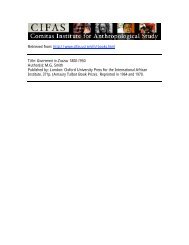Slaves, Free Men, Citizens - CIFAS
Slaves, Free Men, Citizens - CIFAS
Slaves, Free Men, Citizens - CIFAS
- No tags were found...
Create successful ePaper yourself
Turn your PDF publications into a flip-book with our unique Google optimized e-Paper software.
This selection deals with structural aspects of the EastIndian-Creole issue within a "plural SOC1ety" framework.We are given a view of the ordering as well as of the dynamicaof the Guyanese social order on the eve of nationalindependence. Drawing from the literature on pluralism,the author conceptually diatinguiahea the local and nationalinstitutions that facilitate the functioning of the social system.'The identilication of"maximal," and"brokern institutions makea possible the examhwion ofprocesses of change and political maneuvering in a pluralsetting. In addition to its intrinsic theoretical importance,this selection provides an overview of the only CommonwealthCaribbean SOC1ety with an East Indian majority.LEO A. DESPSSS, an American, received his doctorate inanthropology from Ohio State University and is currentlyProfessor of Anthropology at Case Western Reserve University.Cultural Pluralism and NationalistPolitics in British GuianaLeo A. DespresTUB STRUCTURAL DE&fENSIONS OF PLURALISM 'la developing an analytical framework for the malyasof social and cultural pluralism, it has been auggectod thatthe definition of the plural society must take into accounttwo related sets of facts. First, it must take into accountthe extent to which particular groups display different s ptern of culture as evidenced by the activities their membersengage in. Second, it must also take into account thelevel at which aocial activities serve to maintain culturaldifferentiation as the basis for 800ocultural integration.The criteria used to determine the degree of cultural differentiationbetween group are structural. It has been 8ssumedthat the institutional structures which serve to replate the activities of individuals in ~ pare expressive s ofthe cultural values charaderiatic of the group in question.From this assumption, it follows that different inatitutiodstructw m e to &tit@& merent culturea and socialunits.1In extending this analytical framework further, a d bCultural Pluralism and Nationalist Politics in British Guiana,copyright @ 1967 by Rand McNalfi & Cornpany, Chicaw, PP.270-85. Reprinted by permission of the publisher and thethor1 Thia conceptualization is. implicit in Parsons* discussion ofinstitutional structures. See Talcott Parsons, 'The Position ofSociological Theory," American Sociological Review, VOL 13(1948), pp. 155-64, particularly pp. 159^0.





